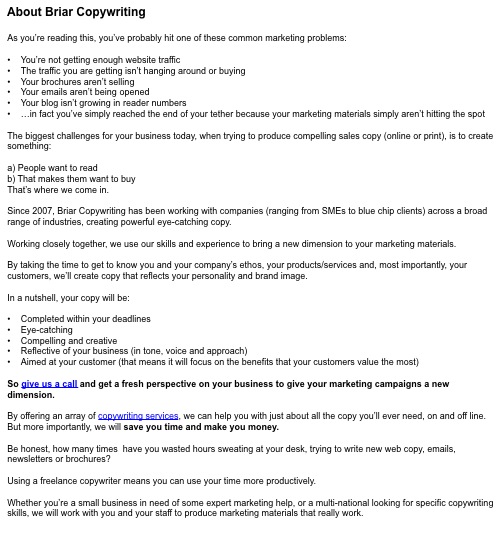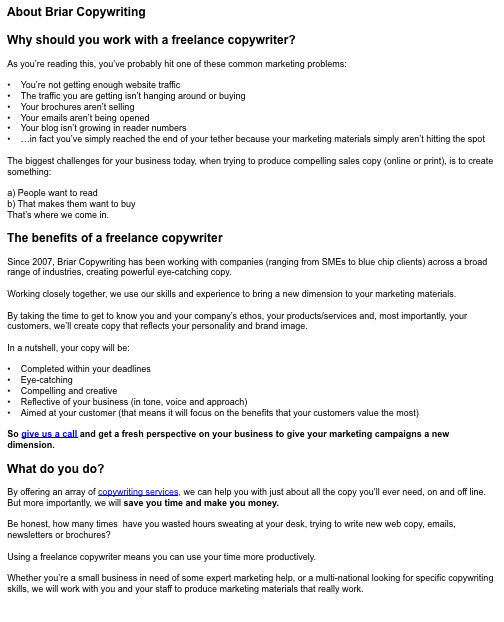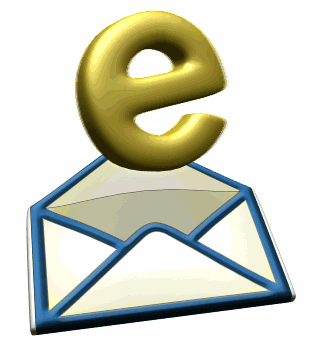Entries Tagged 'copywriting tips' ↓
December 28th, 2012 — copywriting, copywriting tips, direct mail campaign, effective copy
Ask any professional copywriter and they’ll tell you the power of persuasion lies within the copy of any piece of marketing material. Ask any designer and they’ll tell you it is the eye-catching design that will sway the reader.
So who’s right?
Well in a way they both are. Let me explain.
Your audience wants to be seduced; they want to be wooed by high quality sales messages that are not only engaging when read, but that also look the business.
Let’s face it, a glossy mailing that arouses curiosity is more likely to be read than a folded piece of A4 paper covered in Courier font that’s splattered with italics, bold words and underlining.
Admittedly, these letters do work in some markets, but personally I can’t stand the things and always launch them bin-wards when they arrive through my door (or if it’s on a website I navigate away faster than a fast thing).
But there’s no getting away from the fact that a quality mailing will give a better return.
Words and design go hand in hand
The main trick for any mailing is to ensure the copy and the design marry. For example, if you send out an elegant flyer that’s accompanied by text that’s very informal and more akin to something you’d expect to find in a text message (extreme example), it won’t work.
Or will it?
Perhaps that sort of disparity would work – it would certainly get your mailing noticed and talked about.
And, after all, that’s what it’s all about isn’t it? Getting noticed?
There’s a challenge for someone – to come up with an elegant ‘up market’ style flyer that contains text-speak language. I’d love to see the results.
The same goes for copy.
Why are there so many people out there who feel the desperate need to flag up the tiniest of errors just because they can? No one is perfect (nope, not even me) and errors do happen.
But there are some copywriters who will even – shock horror – make spelling or grammatical errors on purpose.
A well-placed typo can bring attention to a key point; flouting the rules of grammar can have the same effect – after all, rules are there to be broken aren’t they? And people have been breaking grammatical rules for centuries.
Of course there is a huge difference between a well-placed faux pas and an ignorant and careless mistake.
Your reputation in your hands
What it comes down to is your mailing, or whatever form of marketing you care to mention, holds the key to your customers’ perception of your company.
It’s human nature to judge ‘a book by its cover’ (please excuse the cliché) and however hard you try not to, you won’t be able to help yourself.
So one sloppy mistake, one misjudged mailing, one ill written letter, will tarnish your business forever (well, for quite a while anyway).
December 17th, 2012 — Content writer, copywriter, copywriting, copywriting tips
Content rules the Internet and considering most of that is in the form of words, that’s a lot of reading.
You all know that reading from a screen is more difficult than reading from books or magazines. That’s not to say that your intellect suddenly falls several points when faced with a computer screen, but rather reading from a back-lit screen can be rather tiring on your eyes, which leads to less concentration.
That’s why its important to use sub headings – a feature used by every professional copywriter you’ll come across – because they make it easier for readers to read.
The best way to show you the effect sub headings have is through an actual illustration. Below is a sample of copy taken from by About Us page – first of all without any sub headings:

As you can see, even with the paragraphs intact the piece doesn’t really make you want to read. The text looks too dense and there is no direction as to what information the page contains.
Now let’s look at it again with the sub headings in place:

This time there is much more structure to the page. The sub headings act as signposts telling the reader what information the page contains making it easier for them to navigate to the section they want to read.
The aesthetics of sub headings
Aesthetically, the page looks more inviting with sub headings: a solid wall of text gives the impression that the subject matter is going to be difficult to read and boring, so it won’t encourage people to give up their valuable time to read it.
With sub headings the reader can break the page down:
- The sub headings act as rest points; the reader can break of at any time and not lose their place.
- They can glance down the page and pick out the information they need
- They give the impression of an ‘easy read’, which subconsciously suggests the information will be easy to grasp
So you see, just the simple inclusion of sub headings in your writing can boosts its readability.
Next time you’re writing website copy, brochures, blogs or articles, pay special attention to how you lay the information out. Use sub headings and short paragraphs to make it easy to follow and understand, that way you’ll boost your engagement with your readers.
December 14th, 2012 — briefing a copywriter, copywriter, copywriting tips
Anyone who has hired a professional copywriter to help with their sales and marketing materials will understand the collaborative process that lies behind a successful relationship.
Once you’ve briefed your copywriter and told them all they need to know, they’ll go away and create a first draft.
So what do you do when that first draft pops up in your inbox?
Reviewing the copy should be done in three separate steps.
Here’s the first.
1. Get to know it
First of all you have to get to know the copy. That means reading in through to get a sense for the writing.
Reading it out loud is a great way to get to grips with it. As you go through it, make a note of any places where your attention slips, or areas that you find confusing, or that simply don’t seem to flow well.
Once you’ve done that, you’re ready for step two.
2. Soft edit
A soft edit solely looks at the spelling, punctuation and grammar. In theory, as you’re using a copywriter, there shouldn’t be too much to do here, but typos can be notoriously hard to spot, so one or two may slip through.
Once that’s done, you’re ready for the final step.
3. Hard edit
This is where you need to look at the content itself and highlight areas that may be incorrect or where information should be expanded.
In theory, your brief should have been comprehensive enough for your copywriter to add all the detail required, but sometimes things get missed.
This is the point where you have to place your trust in your writer’s abilities and trust their professional instincts, which have been honed over many years.
Put your feelings aside and forget about how you would have written it – that means word choice, sentence structure and use of rhetorical devices.
If you just wade in changing things willy-nilly because ‘you would have written it differently’, you might as well have just written it yourself.
You hired a copywriter because:
- You don’t have time to do it
- The materials you were using simply weren’t working
- You don’t have the necessary skills to produce great copy
They’re not going to write like you; they’re going to write like a professional writer who has a lot of experience in what they do – so trust them.
December 12th, 2012 — copywriting tips, effective copy, email copywriting
There are loads of articles on the Internet telling you how to get the most from your email marketing, but what about the emails you send to clients and colleagues every day?
You may think that because they have nothing to do with direct selling the way you write them is not that important.
Really?
How many times have you sent an email to someone with a request that never gets answered? Or how about one that asked several questions and you ended up sending numerous other emails because the recipient didn’t answer everything first time round?
The way you write your daily emails will have an impact on your efficiency.
You might think that’s an odd thing for a marketing copywriter to be writing about. But everything you write in your business has to be persuasive enough for someone to take an action – even if that is just to open your email and read it.
Email subject lines
The subject line is always a good place to start.
Let’s face it, we are all inundated with emails every day and have to make quick decisions about which ones get our attention first.
Those that have subject lines such as:
- Hello
- FYI
- It’s been a while
- 2013 Report on the risk analysis of the environment impact….
Are unlikely to grab you as emails that have to be opened, read and actioned immediately.
But if you start it with something like:
- We need your decision today
- Please reply yes or no
- Your feedback is needed for today’s meeting
It’s more likely grab the recipient’s attention.
Call to action
The staple requirement for all copywriting projects, calls to action are also necessary in your emails.
But don’t leave them to the end – if you want someone to act quickly, tell them straight away. It’s important they read and action your email, so the first sentence should tell them that.
If you leave it to the end, you run the risk of them getting bored and moving on to a different email or having a sneaky game of Solitaire.
To chase or not to chase
Of course it’s OK to chase an email if you’ve not had a response, but not within a couple of hours of sending it.
Come on, be realistic – not everyone checks their emails every 5 minutes. If they did they’d never get anything else done.
If you need a speedy reply and you’ve not heard from them within a couple of days, fine, send a polite chaser or call them.
One subject
It’s very tempting to send one very long email covering everything you want someone to do.
The problem is, your email will come across as garbled, rambling and downright confusing.
By covering one topic at a time, everyone will know where they stand and things won’t get missed.
Be brief
This one is related the one above.
Trying to cover too much in one email will just lead to confusion. Keep your message brief and to the point; why not use bullets and numbered points to help the recipient keep track of what’s required – it will also make it easier to respond to.
None of this is ground breaking stuff, but every now and then we need reminding.
How you communicate with others will not only have an effect on them, it will also impact on your own efficiency and productivity.
Make sure your messages are clear and to the point – and if it’s something that can’t easily be explained via email, rather than trying, pick up the phone.
December 5th, 2012 — copywriter, copywriting tips, effective copy, Home Page, website copywriter, website copywriting
The art of website copywriting is a complex one.
Many website’s that have been written in-house tend to make the same mistake.
No, we’re not talking about bad grammar or blaring typos (although that may be true in some cases), the problem is with the actual content itself.
You see, although your website exists to bring your company to the attention of your market place, it isn’t there to shout about you.
Confused?
Think about it this way. Imagine you’re out looking for a new pair of shoes. As you walk down the High Street you spot a gorgeous looking shop with oodles of ‘must have’ shoes in the window.
Its upmarket feel and the immaculately displayed shoes, boost and sandals seduce you. Before you know it you’ve walked through the door and an assistant is approaching you.
You expect them to greet you, ask how you are and what you’re looking for – are you looking for shoes for a special occasion….really, a Ball? How wonderful, what’s your dress like? You know, niceties like that.
But what they actually do is tell you all about the company, how long they’ve been trading, what car the MD drives and how they believe they are the most unique shoe retailer in the country.
I don’t know about you, but I would be out of there faster than a fast thing.
The same thing goes for your website.
Your Home Page is likely to be the page that most visitors arrive at, so it’s the first impression they’ll get of your company. But rather than reading about how amazing your company is, it needs to be focused 100% on the needs of your customers.
Why should they buy from you?
No, not because you’ve been in business since 1889….They should buy from you because you offer unique shoes, shoes that will make them feel special, shoes that people will stop and stare at, shows that will show the world how successful they are, shoes that will make people stop and stare wishing they could be just like them.
OK, a bit OTT, but you get the picture.
The copywriting on your home page must be all about the benefits your customers will enjoy if they buy your product (or service). It must communicate to your reader that you’re a company that puts its customers first.
Over to you
Take a look at your Home Page – who is the main focus on, you or your customers?
If it’s you, it’s time to change your copy – if you need a hand, get in touch with a professional copywriter and get your copy working for you.










